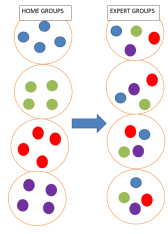I was recently in a seminar with 30 confident, competent professional people. After a few excellent presentations the floor was opened for discussion, it started slowly, partly because of the layout of the room and perhaps also because the floor was too open. That is, there was no driving question, so it was a meandering stream of consciousness from a few participants.
Gradually we picked up steam and a number of people spoke. I can’t tell you where the discussion went, or what the salient points were. I really lost focus because I suddenly realised one startling thing. The only people who spoke were men. To be fair, there were 20 men and only 10 women. But not one woman spoke.
Fast forward to a few days later. I was speaking with a student and teacher. The teacher was making the point that the student needed to participate more in classroom discussion. He explained that these discussions were an important part of the learning that took place.
We threw around a few strategies to increase the student’s participation, but she just didn’t seem that convinced. After the teacher left, the student turned to me and she said “the class is almost all boys. They talk all the time and there is no space for me.”
Of course, two anecdotes do not constitute valid or reliable research. However, the two events stopped me in my tracks. Why were the girls/women silent? Are the silences in classrooms of today, the silences of workplaces tomorrow? And what can we do to help our quiet students, whoever they are, to speak up?
While there are systemic things that our institutions should be doing, here are few thoughts on things that can be done in our classrooms to help students find their voice.
Be intentional – look around in your classrooms and ask yourself “who are the quiet students”? They have probably already come to mind as you are reading, although you might not be able to name them because (brutally) you don’t actually know their names. Who are they? Are they mainly girls, perhaps in your class it’s the boys, or the disinterested, the school-haters, the students with English as a second language. Perhaps it is not a discernible group, just a few students spotted around the room. Whoever they are, the first step is knowing who they are.
Thing about your behaviour – do you create an uneven culture of power and participation. Is there something that you are doing that says, for example, that boys’ opinions are more important. Do you tend to always ask the same students for their opinion, or cut some students short. Are you wary of some students’ answers and so don’t let them talk for long?
Look at your room – how does its layout support the sharing of ideas? Can students see each other, or is it easy for them to fade out? Can students hear each other? What can you do to make the room a better space for discussion? If you’re fortunate you will be able to reorganise the seating plan. But if you teach in a room where you can’t move the desks you will have to think more creatively about this. Perhaps you can move the chairs, or ask the speaker to stand, or walk to where the speaker is seating so that you guide the rest of the class where to look and listen.
Work out your role – does everyone face you and wait for you to control what happens, or do you stand to the side and offer no guidance, refocus questions or encourage quiet students. We need to find the right balance between abrogating responsibility and taking over. I believe that it is important that a teacher provides plenty of guidance and direction in a discussion, and works to keep the whole class focused. My favourite question: “what makes you say that?” Is a useful tool for encouraging more thoughtful discussion and may help silent students speak up.
Provide easier ways to be involved – speaking in front of a large group can just be too difficult for many people. Breaking into smaller groups and using think-pair-share are both helpful. Also asking students to indicate their opinion non-verbally, for example by showing with “thumbs up” or “thumbs down” what they think of someone else’s statement, will help silent students have a voice.
Train students in discussions – somehow we seem to expect students to know how to participate in a discussion. But there are lot of skills required for an effective discussion to take place. By training in specific skills, we help students to be more courageous in their participation. For example, you can:
- model questions and responses for students to use by joining in on the discussion
- provide students with specific roles to play in the discussion
- give students a set of tasks they must complete in the discussion, for example everyone must ask a question, answer a question, add to what another person has said.
- ask students to write down their ideas prior to the discussion so that they can read their notes
- help students develop personal goals for discussion time. For example, I am aiming to give one opinion in today’s discussion
Praise students – this is not just a generic “well done today”; this is specific praise that explains what the student did well so that he or she can build on the skill. For example, say something like “I really like the way that you gave an example from the book we have been reading today.” Or “Thanks for explaining to John why you agreed with, that’s really helpful in a discussion.”
Create a classroom that is safe, caring and compassionate – When we work at making the classroom a place where students feel safe enough to say something, we are more likely to create a space where they are confident that all people will respect their right to speak.
Let’s work hard to give every student a voice in our classrooms.
God bless, Kaye


 The advantages of this approach is that all students must participate in the learning because they will all have to share with their Expert Groups what they learned. No one can sit on the sideline and watch another student do the work for him or her.
The advantages of this approach is that all students must participate in the learning because they will all have to share with their Expert Groups what they learned. No one can sit on the sideline and watch another student do the work for him or her.